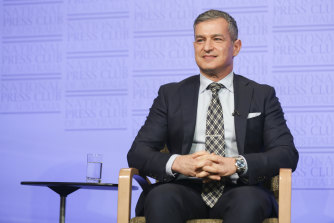The Australian Council of Trade Unions has pushed for a 5 per cent rise in the minimum wage in submissions to the Fair Work Commission’s annual wage review which must be completed by July, while the Australian Retailers Association (ARA) has called for a “measured increase”.
“We do believe a wage increase is inevitable,” ARA chief executive Paul Zahra said. “However, we believe this increase in wages should be based on the actual rate of underlying inflation, less the impact of increases in superannuation.”

Australian Retailers Association boss Paul Zahra.Credit:Alex Ellinghausen
Zahra said higher operating costs, freight and packaging costs had been absorbed over the past few years but retailers now had “no other option other than to pass on higher costs to consumers”.
Former Myer boss and retail veteran Bernie Brookes supports a rise in the minimum wage but said his business, handbag and jewellery chain Colette, was already paying more to attract store managers and IT professionals.
“There is a bit of a war for talent,” Brookes said. “The world has changed and a lot of people aren’t prepared to work five days a week in a grocery store or retail environment.”
Loading
Bunnings human resource director Damian Zahra said staff received a wage review each year that took inflation into account. Difficulty hiring in-demand roles continues to affect the hardware chain, while a Coles spokeswoman said there were new recruitment processes for the supermarket giant after “unprecedented labour shortages” late last year.
Michelle Bilston, a Melbourne retail worker of 35 years, said her pay rises over the past five years hadn’t kept pace with her increasing rent, grocery and utility bills.
Her most recent rise was about $10 a week but she said she now spends $50 more a week than before the pandemic. “If I lost my job tomorrow it would be a couple of weeks before I couldn’t pay my rent,” she said.
Grattan Institute economic policy program director Brendan Coates said businesses should expect wages to rise due to low unemployment but it would take until 2025 to make up for workers’ wages crawling alongside inflation for the past decade.
Treasury figures show wages grew on average at 2.3 per cent annually for the 10 years until December 2021, while the CPI had grown at an average rate of 2 per cent per year.
“At the moment, people are going backwards because of these global supply shocks, there’s not much that policymakers can do about that – when you have a global supply shock, it makes people poorer,” Coates said.
“It’s going to take time to work through but you’re much more likely to have real wages growth with low unemployment.”
The Morning Edition newsletter is our guide to the day’s most important and interesting stories, analysis and insights. Sign up here.








